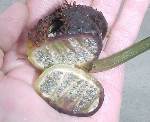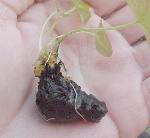 |
Seed or Rhizome? or The Truth About Plants Grown From Both (With input from our email discussion list) Click images to enlarge |

|
The question often arises among water gardeners of whether to grow waterlilies and lotuses from seed or rhizome. The answer is it depends on what you want to have in the end. Here we will try to explain how seeds and rhizomes produce differing results - and not always what you think you are getting.
The term rhizome is, in this article, used interchangeably with the term tuber. Either/both are the means for producing an exact duplicate of the parent plant. This is the method used for reproducing waterlilies and lotuses that are true to name since tissue culture cloning is not yet available for these plants.
Rhizomes/tubers result from the vegetative reproduction of a single plant, so are identical in genetic make-up to that of the parent plant. As a rule, seeds are a combination of genetic material from two separate plants which is the result of pollen from one plant being introduced to the stigma of another (by human, bee or other pollinator). In some cases, seed results from the self-pollination of flowers on the same plant. Either way, if the plants involved are waterlily hybrids and not waterlily species, the resulting offspring can and will differ dramatically from each other and the parents. Only a rhizome/tuber can be used to reproduce a named cultivar.
Species plants of Nymphaea, Nelumbo and Victoria (all plants for that matter), when bred to themselves or another example of the same species to produce seeds, will duplicate themselves. Species are plants originally found in the wild, each one unique and separate from other species. The names of species are Latinized and written in italics where cultivar names are written in plain type. To determine whether a plant is a species or cultivar, consult the Names Lists (Waterlilies - Lotus) on this web site or taxonomy databases such as GRIN.
If two different but closely related recognized species are crossed, the result is a primary, or F1 (first generation) hybrid. Plants from the same cross of species, if repeated over and over, will be consistent in their characteristics, reliable and predictable.* Victoria 'Longwood Hybrid' for example is a cross of V. cruziana (seed parent) x V. amazonica (pollen parent), an F1 hybrid.
Without going into the genetics involved, but because of them, a 'Longwood Hybrid' crossed with itself or another 'Longwood Hybrid' will not produce 'Longwood Hybrid'. It will produce an F2 (second generation) hybrid, inconsistent because of a greater number of genetic combinations possible. These, and subsequent generations which we call F-somethings, cannot be called 'Longwood Hybrid'. Any hybrid bred to itself WILL NOT yield the parent.
Nelumbo 'Mrs. Perry D. Slocum' is a hybrid way down the genetic line from lotus species and primary hybrids. Seeds from 'Mrs. 'Perry D. Slocum' WILL NOT produce 'Mrs. Perry D. Slocum' but rather a genetic grab bag of possibilities. The more hybridity involved, the more potential variability. The true plant can only be grown from rhizome. Similarly, hybrid waterlilies bred to themselves will not recreate the original but can produce a wide variety of offspring.
 |
X |

|
|
|
|
|
 |
||||||
|
|
||||||
In order to carry the name of a recognized cultivar, the resulting plant MUST be an exact duplicate of the original. "Almost" isn't good enough. Cultivars have been named in the first place based on carefully considered criteria (see How To Name A New Cultivar) and it's extremely important to perpetuate ONLY the correct plant with the correct name. A seedling grown from a named cultivar CANNOT be given the cultivar's name.** A seedling that resembles a cultivar CANNOT be given the cultivar name.
Once a grown-from-seed plant is deemed outstanding, unique and possibly worthy of a name, the first job of the grower is to get it to multiply, producing plantlets, tubers or rhizomes to make more plants vegetatively, exact duplicates of the original. Once a group of identical plants is available, the cultivar can be named. Subsequent plants reproduced by vegetative means carry the cultivar name.
With the above understood, it should be easy to decide whether to grow waterlilies and lotuses from seed or rhizome. If you want a surprise, grow from seed. If you want a known cultivar, grow from rhizome (or buy plants from a reputable grower).
Victoria is a somewhat special case because it doesn't produce rhizomes or tubers from which it can be grown vegetatively. It can only be grown from seed. This is why we grow the species each year, to carry them forward and to recreate the primary hybrids, 'Longwood Hybrid' and 'Adventure' (the cross in reverse to "Longwood Hybrid'). These, as well as the back-cross hybrids (F1 hybrid x species), are consistent in their characteristics, plant to plant and year to year.
We feel strongly that, to preserve the integrity of Victoria, F2 and later generations of polyglot hybrids should not be grown. There are several reasons for this. F-somethings can be weak, inferior and potentially disappointing. Granted there is the possibility of production of interesting traits but this, without tissue culture to replicate them, is a dead end. Selection for these characteristics over many generations would take more space and time than anyone could or would devote. It is also well known that, over time, F-somethings can revert to species characteristics. There is the potential for an unsuspecting grower to use them for breeding, corrupting the species gene pool.
As incentive for people not to grow F2s and later generations of Victoria, we annually produce and distribute free of charge more seeds of the species and F1 and back-cross hybrids than the world could possibly grow. If you can grow these "blue bloods", why risk the down side of growing F-somethings? We advise you to accept ONLY seeds or plants with a lot number that can be looked up in our Pedigrees or with an accession number from a recognized botanical garden.
We also feel strongly that the practice of attaching cultivar names to hybrid waterlily and lotus seeds should stop. This, as you can see above, can be very misleading to less educated water gardeners. It also constitutes misrepresentation, since growers who offer them usually know better. The same goes for certain unscrupulous commercial growers who routinely send out seedlings of named cultivars instead of true cultivars grown from tuber or rhizome.
To recap, except for species and first generation crosses of two different species, seeds are surprise packages. There is no way to know what you're going to get from them, even if they carry a cultivar name. Tubers, rhizomes and viviparous plantlets, if labeled and obtained from knowledgeable and reputable growers, should be true to name. Either choice can be rewarding.
* Species which have variability within them
can result in some variability in F1 offspring.
** It has been reported that several rare cultivars do come true
from seed but this is not at this time supported by molecular
evidence.